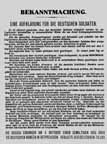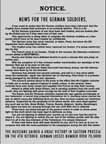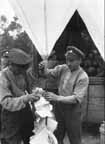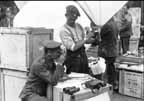 Leaftlet Bekanntmachung, produced by Lieutenant-Colonel Swinton and dropped on German Troops in October 1914. |
 |
| Crown Copyright circa 1920 Typeset by Lee Richards, London. 2001 www.psywar.org Original document held by the Public Record Office, tel: AIR 11628 |
Sir Campbell Stuart, K.B.E. in his hook "Secrets of Crewe House" states that in October 1914 Lieutenant-Colonel Swinton, who was then acting as 'Eye-Witness' with the British Army, prepared a propaganda leaflet with the aid of Lord Northcliffe's Paris "Daily Mail" organisation, and distributed by aeroplane among the German troops. "But" says Sir Campbell Stuart "the Army chiefs at that time did not show any enthusiasm for the innovation, and Colonel Swinton was unable to proceed with the project."(1)
According to a statement by General Swinton he paid the cost of printing out of his own pocket and recovered this from the Army authorities later.(2)
Nothing further seems to have been done in this sphere until Major-General MacDonough became Director of Military Intelligence at the War Office at the beginning of 1916 when a propaganda branch was established in his department. In the spring of 1916 a sub-section of this branch began the preparation of leaflets in German for distribution among enemy troops and one of the means adopted for distribution was by aeroplane.(3)
According to the records of the IV Brigade a sack of newspapers was received on the 3rd April 1916 from fourth Army H.Q. containing the "Feldpost" for dropping over the German lines and the "Voix du pays" for dropping over invaded territory. These and other consignments which followed at intervals of about one month were distributed as requested.
On the 5th August 1916 H.Q. R.F.C. called for a report from brigades as to what extent they were being called upon to distribute papers in hostile territory and whether the amount of papers given for distribution caused any inconvenience.
They were informed that "Special flights for the distribution of newspapers are not to be undertaken without previous reference to R.F.C., H. Q."
The Brigadier-General commanding the IV Brigade replied that papers for distribution in hostile territory were received about once a month and were dropped by aeroplanes whilst performing their ordinary duties. He had not kept a record of the exact number of papers received but their distribution had not caused any inconvenience.
On the 27th June 1917 H.Q. R.F.C. informed brigades that "the distribution of propaganda by aeroplanes over the enemy lines will cease until further orders".
This prohibition was cancelled on the 27th July 1917 when the distribution by aeroplane was ordered to be resumed.(4)
In the meantime there had been certain developments. On the 6th June 1917 the Swiss Minister transmitted to the Foreign Office a note from the German Foreign Office dated 22nd May 1917 stating that enemy airmen on the German Western Front had recently dropped "inflammatory writings, some in particular directed against His Majesty the German Emperor." The note stated that such acts, were in the opinion of the German Government, outside the scope of acts of war, and that instruction had been issued that enemy airmen on whom such writings were found or who have been guilty of scattering them, would be tried by Court Martial.(5) Next information came to hand that British officers of the R.F.C. (captain H.R. Hawkins and 2nd Lieutenants G.O. McEntee, J.D.M. Stewart and G.M. Hopkins) were tried by Court Martial on the 17th October 1917 for "having in April 1917, distributed (by dropping them from aeroplanes) pamphlets, which contained insults against the German Army and Government, amongst the German Army fighting in the Western Theatre of war".
This was claimed by the Germans to he an offence punishable under paragraph 58, sub-para. 9 of the "Militärstrafgesetzbuch" ("Manual of Military Law"). Paragraph 58 (reads) "He will be punished with death for treason who, with the intention to give aid to a foreign power or to prejudice the German or Allied troops". Sub-para. 9 (reads) "Spreads hostile appeals or proclamations in the Army".
According to a report of the trial by Dr. Hoekstra of the Netherlands Legation, Berlin, the prosecuting counsel argued that the accused had committed a breach of international Law and should he tried in accordance with paragraph 58 of the "Militärstrafgesetzbuch" but the fact that the accused belonged to a hostile armed power should be taken into account in mitigation of their offence in determining the penalty to he imposed. He demanded that each of the accused he sentenced to ten years penal servitude which was the minimum penalty for their offence.
The Court considered that under paragraph 160 of the "Militärstrafgesetzbuch" and paragraph 5(4) of the Imperial Military rules of the criminal procedure (sic) German law was applicable in the case of the accused.
Paragraph 160 (reads) "A foreigner or German who makes himself guilty of one of the Acts mentioned in paragraphs 57-59 and 134 during a war against the German Empire, will he punished in accordance with the sentences mentioned in these paragraphs".
 Leaftlet Bekanntmachung, produced by Lieutenant-Colonel Swinton and dropped on German Troops in October 1914. |
 |
In the result the Court found that the charges against Hopkins and Stewart were not proved and they were acquitted on that ground.
As regards Hawkins and McEntee the Court found that there was a prima-facie case against them under paragraph 58 sub-para. 9 of the "Militärstrafgesetzbuch". The Court however were not satisfied that the act committed by the accused was contrary to International Law and even admitting that to be so, the Court considered that the accused were unaware of the illegality of their actions in the eyes of International Law and it must in consequence acquit these two accused likewise.
Alter the end of the pleading the presiding judge read out a declaration by the Higher Army Command stating that the dropping of incendiary pamphlets is regarded by the German authorities as being contrary to International law and that a communication to this effect had been transmitted to the enemy powers through the proper foreign Legation. But says Dr. Hoekstra, "This declaration by the Higher Army Command was, however, made after the event."
Subsequently Dr. Pape, who was one of the counsel for the defence, reported that the acquittal of the four officers had been confirmed. Next a statement appeared in the German Press and was also circulated by German wireless that Second Lieutenant E. Scholtz and H.C. Wookey R.F.C. of No. 11 Squadron who were shot down near Cambrai on 17th October 1917 had been sentenced on the 1st December 1917 by a German court-martial to ten years penal servitude for dropping pamphlets. On the 4th February 1918 a protest was telegraphed to the British Minister at the Hague for communication to the German Government, who were informed that "His Majesty's Government do not regard such action as contrary to International Law and no justification has been produced by the German Government in support of their contention that such action is outside the scope of the laws of war."
The German Government were warned that failing the release of these two officers, His Majesty's Government would proceed to reprisals after the expiration of the months grace in accordance with the Hague Agreement between the two Governments in regard to Prisoners of War.
The following day the German wireless announced that as regards the sentences on Scholtz and Wookey:
"For more than two years leaflets of an inflammatory nature have been dropped behind German lines by English Officers, in order to corrupt our troops and by descriptions with illustrations of the good treatment of German prisoners in England, to induce them to desert."
The allegation was made that two German officers had been court-martialled by the Entente as far back as March 1915 for dropping leaflets and had been condemned to death, the sentence afterwards being commuted to penal servitude for life. It was also alleged that France had announced her intention of court-martialling after capture any German flying officers who dropped leaflets behind French lines and in consequence as a reprisal the two English flying officers found guilty of war-treachery were condemned to ten years imprisonment.
On the 2nd March 1918 a telegram was sent to Sir W. Townley the British Minister at the Hague for transmission to the Netherlands Minister at Berlin for the information of the German Government, in which it was stated that "No German airmen have ever been condemned by H.M. Government for acts similar to those alleged against Lieutenants Scholtz and Wookey. His Majesty's Government are also informed though this does not affect the case that no German aviator has been court-martialled for distributing propaganda by the French authorities, nor has it ever been proposed that they should be."(6)
Meanwhile it was learned that Lt. H. Whitworth, Sec. Lt. W.C. Pruden, Sergeant Everix and Gunner Conlin all of the R.F.C. were in prison awaiting trial on charges similar to those made against Lt. Scholtz and Wookey.
His Majesty's Government therefore on the 21st March 1918 telegraphed to the British Minister at the Hague requesting an immediate assurance from the German Government that:
"(a) the above officers and men as well as Lts. Scholtz and Wookey have been released from prison and sent to a camp befitting prisoners of war and that no further proceedings will he taken against them,
"(b) that no other officers are still in prison on a similar charge."
In the event of non-compliance with these demands reprisals were threatened. On the 19 April 1918 Sir W. Townley telegraphed that he had been informed by the Netherlands Minister at Berlin that Lt. Whitworth and Pruden and Sergeant Everix and Gunner Conlin had been acquitted.
In a note dated 9 March 1918 in reply to the protests of the British Government the German Government stated that the details of the case of Lts. Scholtz and Wookey were not yet known to the German Military Administration as the documents relating to the trial had not yet come to hand for scrutiny. The note stated that a definite reply to the British notes would therefore not he possible within the period prescribed by the British Government and in the meantime the German Government expected that the reprisals threatened by the British Government would not be promptly carried into effect and that the British Government would await the reply of the General Army Administration.
On the 11th March there appeared an announcement in "The Times" by the Prisoners of War Department that Lts. Scholtz and Wookey would be released and returned to their camps. The same day a telegram was received from the British Minister at the Hague containing a communication from the German Government requesting postponement of measures of reprisals as Lts. Scholtz and Wookey were being released to their camps although the sentence passed on them could not be altered. The telegraphic reply which was dispatched on the 12th March stated that "as Scholtz and Wookey are to he released our reprisals will be suspended. It should, however, be made clear that His Majesty's Government in no way admit that the alleged action for which these officers were condemned is one that justifies any sentence and consequently any pardon." The German Government were also requested to state the camp to which Lts. Scholtz and Wookey were being transferred with date of transfer, and to be assured that they were now receiving proper treatment as prisoners of war.(7)
The official German note which followed was dated 28 March 1918 and stated that "The competent Legal Authorities have decided to postpone for the meantime the execution of the sentences passed on Flight Officers Scholtz and Wookey and instructions have been given to transfer the officers in question to the Camp at Karlsruhe."
The British Government were not prepared to recognise any legal grounds for the sentence of British airmen who fall into German hands by reason of their having dropped pamphlets on German territory or having been captured with their machines equipped for that purpose and reprisals were again threatened. Should any such British airmen in the future be treated as other than ordinary prisoners of war.
The German Government in a note dated 30th April 1918 whilst maintaining there [sic] previous attitude suggested that the British Government should expressly forbid their airmen to carry, or distribute provocative literature and the German Government would in turn repeat their existing prohibition on such acts by German airmen. In either case these orders were to be issued or renewed on the 1st June 1918. In the event of the British Government agreeing to this the German Government undertook to obtain free pardon for Lts. Scholtz and Wookey.
The British Government reiterated their refusal to recognise the legality of the German view.
A memorandum dated 1st July 1918 was presented to the British delegates by the German delegates at a Hague Conference dealing with prisoners of war. In this the German Government pressed for a prompt statement of the attitude of the British Government regarding the proposal made in the German note of the 30th April 1918.
In the course of the discussion on this memo which took place between the various Government departments concerned, the Air Ministry as late as September 1918 were inclined to agree to the German proposal "mutually to forbid the use of aeroplanes for the distribution of propaganda" but they considered that the matter in general should be dealt with by the War Cabinet.
In a telegram dated the 4th October 1918 the British Government rejected the German proposal and reaffirmed the views expressed in their previous communication on the subject.
On the 23rd October a telegram was received from Sir. W. Townley in which it was stated that the German Government had withdrawn the order whereby airmen who are captured with inflammatory pamphlets in their possession were to be brought to trial and in consequence action in regard to Lts. Scholtz and Wookey had been suspended.
The reply dated 1st November 1918 noted that Lts. Scholtz and Wookey were still under sentence of ten years penal servitude and requested that the German Government be informed that "His Majesty's Government cannot acquiesce in this situation and must demand the immediate quashing of the sentence upon these two officers."
After the conviction of Lts. Scholtz and Wookey became known the C.G.S. in France ruled that there was to be no distribution of propaganda literature from aeroplane under any circumstances whatever, and that all further distribution was to be carried out by balloon.(8) In fact cards like this were printed and carried in British aeroplanes on the Western Front.(9)

Sir Campbell Stuart commenting on the suspension of aeroplanes for distribution says "This method had the widest limits, and at the same time, was the best means of carrying a large bulk and of distributing with accuracy. Perturbed by the success attained, the Germans threatened to inflict severe penalties upon airmen captured when performing such duties, and, on capturing two British airmen, followed their threats by action. Instead of instituting immediate reprisals, the British authorities tamely submitted and gave instructions for the discontinuance of the use of aeroplanes for the purpose."(10)
"Attention was then directed to alternative methods of distribution and after various suggestions had been investigated it was eventually decided to utilise special balloons for the purpose. In its standard form the propaganda balloon was manufactured at the rate of nearly 2,000 a week. It was made of paper, cut in ten longitudinal panels, with a neck of oiled silk about 12 inches long. The circumference was about 20 feet and the height, when inflated, over 8 feet. The absolute capacity was approximately 100 cubic feet but the balloons were liberated when not quite taut, containing 90 to 95 cubic feet of hydrogen. Leakage of gas was restricted by the use of a suitable "dope" which prevented appreciable diffusion of the gas for two or three hours. The load consisted of some 500 to 1,000 leaflets which were released in batches by the burning of specially prepared cotton wick, similar to that used in flint pipe-lighters. Although runs of 1,50 miles were possible with the balloons produced at the time of the Armistice, the bulk of the leaflets were distributed over an area of from 10 to 50 miles behind enemy lines."
 Men of the Hampshire Regiment attaching leaflets to a balloon, near Bethune, France, 14th September 1918. (Crown Copyright) |
"The prevailing westerly wind in France which was such a drawback to our aeroplanes proved extremely favourable for the propaganda balloons. The unit for distribution consisted of two motor lorries, which took the men, the cylinders of hydrogen, and the propaganda loaded on releases to a sheltered position selected in the morning by the officer in charge after consultation with the meteorological experts. The vans were drawn up end to end, separated by a distance of about ten feet, and a curtain of canvas was then stretched on the windward side between the vans, thus forming a three-sided chamber. The balloon was laid on the ground, rapidly filled, the release attached and lighted, and the balloon liberated, the whole operation taking only a few minutes."(11)
Lord Northcliffe, who had been appointed Director of Propaganda in Enemy Countries in February 1918, repeatedly pressed for the raising of the embargo on the distribution of propaganda by aeroplane. He did not regard the balloon as an effective alternative. Says Sir Campbell Stuart, "it was a curious commentary on the British attitude that the French continued to use aeroplanes for the purpose on the Western Front. Many weeks passed before the War Cabinet agreed to the resumption of the use of aeroplanes, and even then the Air Ministry raised further objection. Finally, all obstacles were overcome, but not until the end of October. In one week 3,000,000 leaflets were prepared for the interior of Germany, and the distribution of these was begun just before the Armistice."(12)
 Checking wind direction before a balloon a release. France, 14th September 1918. (Crown Copyright) |
In a letter to Lord Weir dated 14th October 1918 Sir John Salmond represented that if it was considered necessary that aircraft should be used for distribution of propaganda it could be done without loss of efficiency. He estimated that 7,210 packages could be dropped per week. But he suggested that in view of the fact that the enemy was then in full retreat and "to put it mildly, in an extremely tractable state of mind, it will be a great deal more efficacious to concentrate our efforts on killing him than on educating him."(13)
Eventually the Air Ministry decided that the dropping of propaganda by aircraft was to be undertaken by the RA.F. and this decision was communicated by H.Q. RA.F. to brigades and other units on the 10th May 1918. The plan arranged for D.H., F.E. and H.F., squadrons to do the work, some 7-1/2 tons per week being dropped in favorable conditions.
1. Secrets of Crewe House, by Sir Campbell Stuart. London, 1920--- Page 51.
2. A.H. 68/4. (PRO AIR 1/723/68/4).
3. Secrets of Crewe House ---Page 52.
4. A.H. 204/82/68. (PRO. AIR 1/1588).
5. Admiralty File Mis. Officer, 16th June 1917.
8. A.H. 204/5/2424. (PRO. AIR 1/1155).